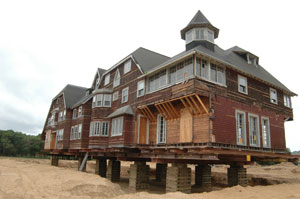Gwathmey Is the New 'Teardown'; House was turning point for architect

It is hardly surprising when a new owner decides to tear down an old house, especially on the South Fork, where "tear down" has become both noun and verb in recent years. When that house was designed by Charles Gwathmey and Robert Siegel, however, its demise may be one for the history books.
The Cogan house, built on Hook Pond in East Hampton in 1972, this spring became the first Gwathmey Siegel house to succumb to the wrecking ball. Gary Fuhrman, who bought the 3.2-acre property on Terbell Lane for $9.5 million, had the house taken down, leaving a rolling meadow in its place. He has filed plans with the Village of East Hampton for an 1,858-square-foot house on the land, but has yet to begin construction.
Designed for Marshall Cogan and later sold to Joan and Joseph Cullman, the place had six bedrooms and a two-story great room with floor-to-ceiling windows facing the pond. A ramp, rather than stairs, connected the first and second floors. It was Mr. Gwathmey's seventh project on the South Fork and Gwathmey Siegel's third large house anywhere.
It earned a residential design award from the American Institute of Architects, a New York State Association of Architects design award, and was named a "record house" by the Architectural Record.
Though the Cogan residence never received as much attention as some of Mr. Gwathmey's other designs, most notably the Amagansett house and studio he designed in 1965 for his parents, Rosalie and Robert Gwathmey, Mr. Gwathmey said last month that it "was a sort of milestone, at a time, for me."
"You do a certain number of buildings and then you do something that's a hit for you and moves you forward," he said from his New York office.
Mr. Gwathmey said he took the design strategies he had developed for his parents to a new level with the place on Terbell Lane, and that it had served as a turning point in his architectural work. He described it last month as "a sculptural building intervened into a larger-scale primary piece."
It represented "a summary and an extended direction that became, for me, a very important reference," he said. "My houses since then have been informed by that dialogue."
He heard through his contractor that the house had been torn down and stopped by the property to see for himself earlier this summer. "It was a very pretty field," he said.
Whether you are a fan of modern architecture or not, there is a certain cachet to having a Gwathmey Siegel house as a neighbor. Marjorie Chester, a design columnist for The East Hampton Star who has lived on Terbell Lane since 1976, said that, while she was not crazy about the Cogan house, "it didn't matter to me at all, it was a Gwathmey house."
She was surprised that Mr. Fuhrman had decided to level it, she said. Mr. Fuhrman declined to comment on the decision or on his future plans for the property, but did say that the house was in bad shape when he bought it.
It was known to neighbors as the Cullman house, Ms. Chester said. "It was always the site of one fund-raiser after another. . . . You went to the Cullman house for galas and cocktail parties."
Mr. Cullman was the head of Philip Morris. The New York Social Diary Web site described the Cullmans, both of whom died last year, as "a very prominent couple in the New York cultural, philanthropic, theatrical, and social circles."
Despite those fancy affairs, Terbell Lane was always a quiet, low-key road in the midst of East Hampton's estate section. "It's one of those lanes where nothing has changed," Ms. Chester said.
Whether its character will endure is anyone's guess. When the Gwathmey Siegel house was torn down, she said, Mr. Fuhrman put a "don't-come-near-me gate" across the driveway.
"I don't so much mind that the house was taken down, I mind the big white fence," she said.
Mr. Gwathmey seemed unperturbed by the destruction of the Cogan house. "People have different perceptions and different needs," he said. "We have a couple of houses in Bridgehampton that were renovated by other architects. For me that's more difficult."
Three years ago, he renovated his parents' house in Amagansett, which is now his own. "Those houses were very basic. They weren't elaborate," he said of his earlier designs. "There's a lot that's happened technologically in the world since then."
While the house is gone, "I still have it published. I have the photographs," he said. "As a creative person, you move on, your work develops. You did it, and that's forever."
